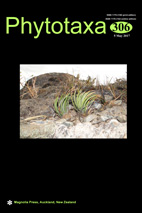Abstract
Aspidistra Ker Gawler (1822: 628) comprises more than 160 species in subtropical SE-Asia, mainly distributed in southern China and adjacent northern Vietnam (Li 2004, Tillich 2005, 2014). In recent years, many new species have been discovered and described from Guizhou Province, southwestern China (He et al. 2011a, 2011b, 2013, Liu et al. 2015, Sun et al. 2014, Xu et al. 2010, 2015a, 2015b). In May 2013, when investigating limestone plants in Guizhou province, we discovered an unusual Aspidistra Ker Gawl. at Dadaihe Karst Tiankeng (Tangbian, Pingtang county), showing dark purplish red flowers, but the pistil was wilted because the plant was at late stage of anthesis. Therefore plants were collected and transferred to the Guilin Botanical Garden, where they flowered next spring. In November 2015, the second author (Meng-Qi Han) collected again the same Aspidistra pecies at Anjiadong Karst Tiankeng (Tangbian). After consulting herbarium specimens and relevant literature on Aspidistra (Huang et al. 2015, Lin et al. 2015, Liang et al. 2016, Ly & Tillich 2016, Pan et al. 2016, Vislobokov et al. 2016), it turned out that the plant represents a new species, which we describe below.

